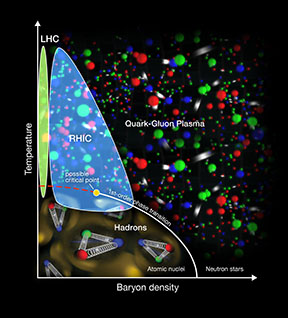
Green Light for Cool Electrons
A new high-power green-light laser generates beam-cooling electrons at the Relativistic Heavy Ion Collider.

A new high-power green-light laser generates beam-cooling electrons at the Relativistic Heavy Ion Collider.

Scientists discover new signposts in the quest to determine how matter from the early universe turned into the world we know today.

Using fast particles to probe hot matter in nuclear collisions.

New data that "wimpy" gluons, the glue-like particles that bind quarks within protons, have a big impact on proton spin.

Antiproton pairs generated in high-energy heavy-ion collisions interact with a strong attractive force.

Nuclear physicists colliding football- and sphere-shaped ions discover evidence supporting a paradigm shift in the birth of the quark-gluon plasma.

RHIC physicists discover key evidence for a long-debated phenomenon in particle collisions.

Particles colliding at nearly light speed reveal information about the true nature of matter.

Scientists shed new light on a proton's spin, refining our understanding of nuclear physics.

New detector component picks up particles composed of heavy quarks to probe primordial quark-gluon plasma.

Particles flowing from heavy ion collisions at RHIC and LHC reveal properties of new form of matter.

Novel high temperature superconductor magnet technology charts new territory.